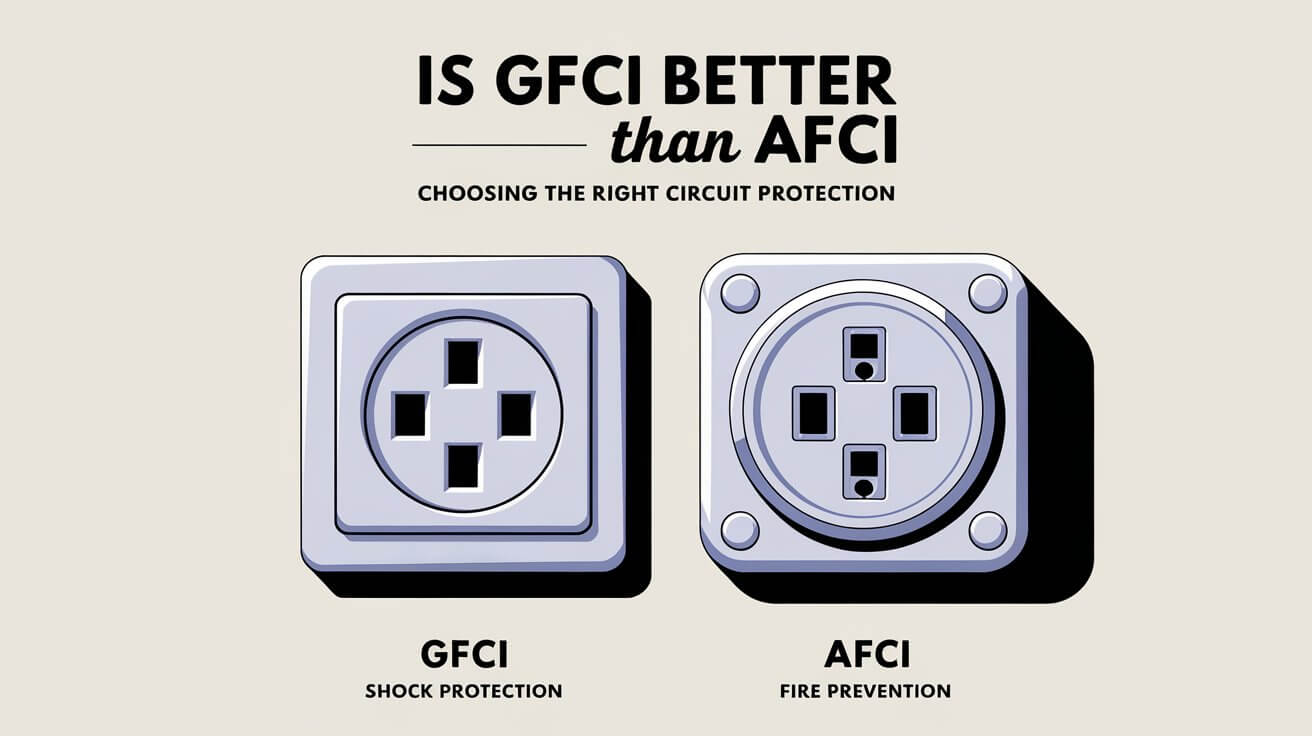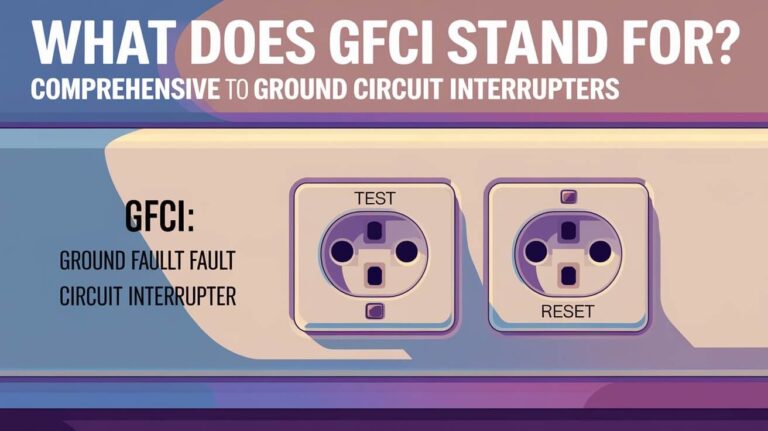Is GFCI Better than AFCI? Choosing the Right Circuit Protection

Both GFCI (Ground Fault Circuit Interrupter) and AFCI (Arc Fault Circuit Interrupter) are critical for electrical safety, but they serve distinct purposes. GFCIs primarily protect against electric shock in areas with high moisture, while AFCIs are designed to prevent electrical fires caused by arc faults. So, is GFCI better than AFCI? The answer depends on the specific type of protection you need. In this article, we’ll break down the differences, benefits, and ideal use cases for GFCI and AFCI devices, helping you determine the best option for different areas in your home.
Understanding the Basics of GFCI and AFCI
What is a GFCI and How Does It Work?
GFCI, or Ground Fault Circuit Interrupter, is a device that monitors the current flow in a circuit and quickly shuts off power if an imbalance occurs. This imbalance could indicate that electricity is flowing through an unintended path, such as water or a person. GFCIs are known for their quick response, cutting off electricity within milliseconds, significantly reducing the risk of electrical shock.
Typical applications for GFCI outlets include:
- Bathrooms
- Kitchens
- Outdoor areas
- Garages
In these areas, water or moisture exposure increases the risk of ground faults, making GFCIs essential for protecting individuals from electric shock.
What is an AFCI and How Does It Work?
An AFCI, or Arc Fault Circuit Interrupter, serves a different purpose. AFCIs are designed to detect arc faults, which occur when there’s a breakdown in the insulation or connections within wiring, causing electricity to “jump” through gaps. These arcs produce high heat, which can ignite nearby combustible materials, leading to a fire. AFCIs monitor for unusual electrical patterns that signal an arc fault and automatically cut power before a fire can start.
AFCIs are required in areas like:
- Bedrooms
- Living rooms
- Closets
Since 2002, the National Electrical Code (NEC) has mandated AFCI protection in more areas to help prevent fires caused by faulty wiring and arc faults.
Key Differences Between GFCI and AFCI
Functionality Differences
The primary difference between GFCI and AFCI lies in their functionality:
- GFCI: Protects against ground faults that can cause electrical shock.
- AFCI: Prevents electrical fires by detecting and stopping dangerous arc faults.
Design and Mechanism
GFCIs and AFCIs operate based on different mechanisms:
- GFCI: Monitors current flow and shuts off power if it detects any imbalance between the hot and neutral wires.
- AFCI: Uses electronic sensors to detect arc patterns in circuits, shutting down power if an arc fault is detected.
Both devices can be installed as outlets or circuit breakers, and dual-function models combine GFCI and AFCI protection into one unit, which is especially useful in areas requiring both types of safety.
Where Each Device is Typically Required
The National Electrical Code (NEC) provides specific guidelines on where each type of protection is needed:
- GFCIs: Required in areas with high moisture (e.g., kitchens, bathrooms).
- AFCIs: Required in living spaces where electrical fires from arc faults are a risk (e.g., bedrooms, living rooms).
Local code variations may apply, so homeowners should check requirements specific to their area.
Pros and Cons of GFCI and AFCI
Advantages of GFCI
- Protection Against Electric Shock: GFCIs offer robust protection against ground faults, which are common in wet areas.
- Fast Response: GFCIs can shut off electricity within milliseconds, minimizing the risk of serious injury.
- Code Compliance: GFCIs are often required by code in high-moisture environments, such as kitchens, bathrooms, and outdoor locations.
Advantages of AFCI
- Fire Prevention: AFCIs protect against dangerous arc faults that can lead to electrical fires.
- Whole Circuit Protection: Some AFCI breakers can protect an entire circuit, not just the outlet itself.
- Advanced Detection Technology: AFCIs can distinguish between harmless and dangerous arcs, helping prevent unnecessary trips.
Limitations of GFCI and AFCI
- GFCI Limitations: GFCIs don’t prevent fires caused by arc faults, so they aren’t ideal for areas where faulty wiring may lead to a fire.
- AFCI Limitations: AFCIs don’t offer shock protection and are not recommended for wet locations.
- Compatibility with Older Wiring: In some older homes, AFCIs may be more prone to nuisance tripping due to existing wiring issues.
Understanding these limitations can help homeowners and electricians make informed choices about the best type of protection for each area.
When to Use GFCI, AFCI, or Both
Choosing the Right Circuit Protection for Different Areas
When deciding between GFCI and AFCI, consider the specific risks associated with each area in the home:
- Bathrooms and Kitchens: These areas should have GFCI outlets due to the risk of water exposure.
- Bedrooms and Living Rooms: AFCI protection is essential in these areas to prevent fires from arc faults.
- Outdoor Areas and Garages: GFCI is the best choice to protect against shock hazards due to exposure to moisture.
Combining GFCI and AFCI Protection
In some cases, both GFCI and AFCI protections are recommended. Dual-function GFCI/AFCI devices are available, combining the shock protection of GFCI with the fire prevention of AFCI. These devices are convenient for areas where both moisture and potential wiring issues are concerns, such as laundry rooms and kitchens.
Installation and Testing of GFCI and AFCI Devices
Installing GFCI and AFCI Devices
Installing these devices correctly is crucial for effectiveness:
- GFCI: GFCI outlets are typically installed in high-moisture areas by replacing standard outlets. For added safety, some choose GFCI circuit breakers for whole-circuit protection.
- AFCI: AFCI outlets can be used in areas prone to electrical fires, while AFCI circuit breakers provide comprehensive circuit protection.
For DIY installation, homeowners should ensure they follow NEC guidelines and consider hiring a licensed electrician to avoid errors.
Testing and Maintenance
Both GFCI and AFCI devices should be tested monthly to ensure they function correctly:
- GFCI Test: Press the “Test” button to trip the outlet, then press “Reset” to restore power.
- AFCI Test: Similar to GFCIs, AFCIs have a “Test” button to simulate an arc fault, ensuring they’ll trip if needed.
Regular testing is essential, as a faulty GFCI or AFCI may not protect against hazards.
Cost Considerations for GFCI and AFCI Devices
Comparing Costs of GFCI and AFCI
GFCI and AFCI devices vary in price, with GFCI outlets typically being more affordable than AFCIs. Dual-function GFCI/AFCI devices are the most expensive but offer the convenience of two protections in one.
Long-Term Safety Investment
While the initial cost of installing GFCIs and AFCIs can be high, they save money in the long run by preventing expensive repairs or liability from injuries or fires. Additionally, compliant homes may benefit from lower insurance rates due to enhanced safety.
FAQs on GFCI vs. AFCI
Can You Use AFCI Instead of GFCI?
No, AFCIs and GFCIs serve different purposes and are not interchangeable. GFCIs protect against shock hazards, while AFCIs prevent fires from arc faults. In some cases, using both is necessary.
Do All Outlets Need AFCI and GFCI Protection?
NEC mandates GFCI and AFCI protection in specific locations. Older homes may not require updates, but installing both devices is still recommended for improved safety.
What Are the Signs of Faulty GFCI or AFCI Outlets?
Frequent tripping or an inability to reset can indicate a problem with a GFCI or AFCI outlet, suggesting a need for inspection or replacement.
Conclusion
In the debate over “Is GFCI better than AFCI,” the answer depends on your needs. For moisture-prone areas where shock risks are high, GFCIs are essential. In areas prone to arc faults and potential fires, AFCIs offer the best protection. Combining both in the form of dual-function devices may provide the most comprehensive protection for certain spaces. For optimal home safety, it’s always wise to consult a licensed electrician who can assess your wiring and provide guidance on the best solution for each area of your home.




